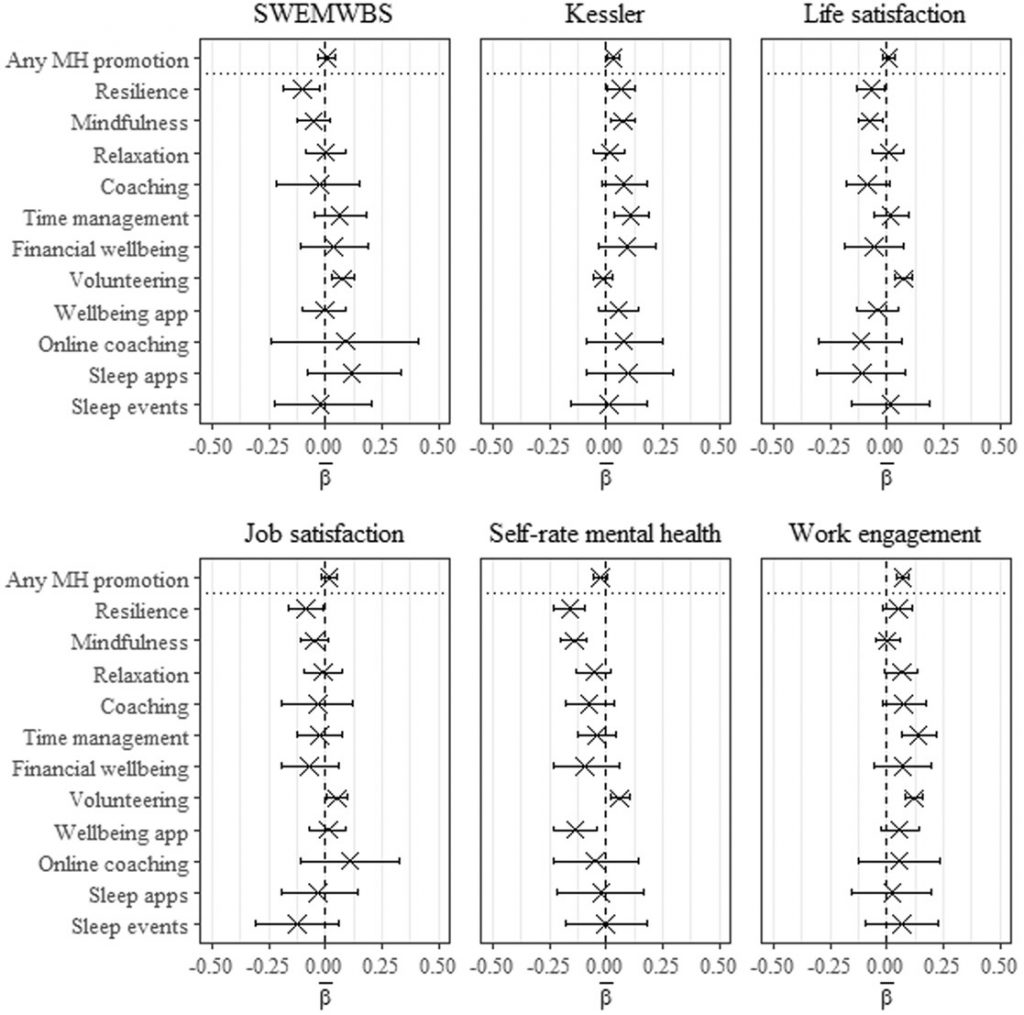
The corporate wellness industry is growing, with its value expected to jump from $61 billion in 2023 to $85 billion by 2030. According to the 2024 Employee Wellness Industry Trends Report, 96% of health insurance brokers anticipate their employer clients will either maintain or increase their investment in wellness initiatives in 2024. However, a recent UK study analyzing feedback from over 46,000 workers in companies with wellness programs came to a concerning conclusion: some wellness programs don’t work.
While the study correctly identifies certain inefficiencies in these programs, it also falls short in its methodology, limiting the scope and applicability of its findings. This article seeks to dissect these aspects, offering a balanced analysis of what the study gets right and where it might be misguided. In doing so, it aims to provide insights into how organizations can refine their wellness strategies, addressing both the study’s valid points and its methodological shortcomings.
Pressed for time? Here’s a quick summary…
- Study summary: The UK study looked at employees across 233 companies to evaluate the effectiveness of workplace wellness programs. The author did not find positive effect for any wellness interventions examined, except for volunteering programs.
- Study limitations: The study’s limitations include a pre-COVID focus on the UK, potential selection bias, and a narrow emphasis on mental health and short-term outcomes.
- Core workplace practices: Reasonable workloads, fair compensation, and career progression opportunities are crucial for employee well-being, which wellness programs alone cannot replace.
- Broader organizational changes: Effective wellness programs must be complemented by systemic changes in organizational culture and practices, going beyond superficial initiatives. This involves creating a supportive environment that promotes holistic health and work-life balance.
- Holistic wellness approach: Organizations should adopt a holistic approach to wellness that encompasses various aspects of well-being, tailor initiatives to unique employee needs, and ensure a balance between wellness interventions and solid core workplace practices.
Study Summary

The study, whose findings became widely distributed thanks to a New York Times article, evaluated the effectiveness on popular workplace mental health interventions. It scrutinized a range of mental health initiatives, including mindfulness, resilience training, and digital wellness solutions to study the impact of these programs on employee well-being and work environment perception. The program did not evaluate holistic well-being programs, and given the interconnectedness of health, focusing solely on a single dimension of well-being may be too narrow to develop meaningful and practical conclusions about the efficacy of workplace wellness programs.
Overall, the study found that most mental well-being interventions at work did not significantly improve the well-being of participants compared to non-participants. This applied to various types of interventions, including relaxation practices, time management coaching, financial well-being programs, well-being apps, online coaching, sleep apps, and sleep events. Volunteering was the only type of intervention to confer benefits for employee well‐being.
The researchers even found a negative effect associated with resilience and stress management program across most well-being outcomes, except for work engagement. The findings were consistent across gender, ethnicity, and income groups.

“It’s a fairly controversial finding, that these very popular programs were not effective. If employees do want access to mindfulness apps and sleep programs and well-being apps, there is not anything wrong with that. But if you’re seriously trying to drive employees well-being, then it has to be about working practices.”
– William J. Fleming, the author of the study and a fellow at Oxford University’s Wellbeing Research Center
What The Study Got Right

Methodological rigor: The study applies Bayesian Propensity Score Analysis, which combines existing employee data (like demographics and past behaviors) with current observations (like mental health or job satisfaction changes) to assess the impact of wellness programs. This method can provide an accurate and credible evaluation of how these programs affect employee well-being.
Core workplace practices: The study identifies workload, compensation, and career progression as key influencers of employee well-being, elements that wellness programs alone can’t replace. It also emphasizes the need for broader organizational changes, involving systemic shifts in organizational culture, policies, and practices, moving beyond surface-level initiatives to foster an environment that supports mental health, work-life balance, and employee engagement.
Where The Study Falls Short
Despite its insights, the study faces limitations in its context and methodology, raising questions about its application.
Narrow focus on mental health: The study’s primary focus on mental health interventions, while valuable, overlooks other dimensions of wellness, including physical health, social well-being, and financial stability, and the impact those dimensions have on mental health. A holistic approach would provide a more comprehensive view of workplace wellness.
Contextual & geographical limitations: This UK-based study, conducted pre-COVID, may not fully translate to diverse, post-pandemic work environments. Its timing and geographical focus limit its broader applicability, especially given the global shifts in work practices since COVID-19.
Selection bias & lack of randomization: The voluntary nature of participation in the studied wellness programs could introduce selection bias, as those who opt-in might already be more engaged in wellness practices. This may have skewed the outcomes, potentially understating program effectiveness in changing behaviors.
False dichotomy: The study may inadvertently create a binary choice between core working practices and wellness programs. These elements should be seen as complementary, not mutually exclusive, in fostering employee well-being.
Specific intervention underestimation: While the study assesses individual-level well-being interventions like resilience training and mindfulness, it might undervalue the unique impacts of initiatives targeting other dimensions of well-being and unique employee needs. This could lead to an underestimation of some programs’ effectiveness.
Lack of qualitative insights: Relying mainly on quantitative data, the study may miss out on qualitative insights that could offer a deeper understanding of employees’ personal experiences.
Cross-sectional data collection: By collecting data at a single time point, the study may not effectively capture the long-term effects of wellness interventions, which is crucial in understanding their sustained impact.
Ignores value on investment: Many companies offer employee wellness programs for reasons that go beyond improving health. The study did not explore the benefits of employee wellness programs on productivity, recruitment, retention, or other factors employers consider when assessing value.
Beyond The Study: A Holistic Approach To Wellness

To realize the value in employee well-being programs, employers first must identify where they expect to see value. For modern, progressive organizations, the focus goes beyond reducing health care costs (often referred to as return on investment) to include other metrics such as productivity, employee morale, retention, and satisfaction (collectively, often referred to as value on investment). To optimize the value an organization gains from their employee wellness program, they must embrace a holistic, multifaceted approach to wellness that incorporates multiple dimensions of health and goes beyond traditional initiatives.
Balanced Strategy

Successful wellness programs thrive in companies that support a culture of health. Building a culture of health includes establishing policies and operations that recognize the importance of well-being in company success. Wellness initiatives should complement, not replace, these fundamental workplace practices, which include:
- Reasonable workloads
- Fair and competitive compensation
- Ample opportunities for professional development and career advancement
Integrating wellness into organizational policies and practices fosters an authentic and comprehensive approach to employee well-being.
Beyond Mental Health
While mental health is essential to well-being, holistic wellness also encompasses physical, social, financial, spiritual, occupational, and environmental health. As noted in the study, volunteering opportunities boost spiritual well-being by promoting a sense of purpose and accomplishment among employees. Another prime example is the connection between physical fitness and mental health. Wellness programs should embody a holistic approach to ensure a well-rounded approach to employee well-being and benefit from the interconnectedness of various dimensions of health.
Tailored Interventions

Customizing wellness programs to unique organizational and employee needs maximizes their effectiveness. This can be achieved by:
- Assessing employee needs: Conduct surveys, focus groups, or one-on-one interviews to understand employees’ wellness needs. This can uncover variances based on factors like job roles, age groups, or work-life balance challenges.
- Industry-specific considerations: Different industries have unique stressors and health risks. For example, a tech company might focus more on ergonomic interventions and mental health, while a manufacturing firm might prioritize physical health and safety training.
- Cultural sensitivity: Tailoring programs to align with the cultural background and values of employees ensures greater inclusivity and relevance. This might involve considering language preferences, cultural practices, or dietary preferences in wellness offerings.
- Flexible offerings: Offering a range of wellness options allows employees to choose what best suits their interests and needs, from physical health challenges to mental health support.
- Generalized vs. personalized support: Broad initiatives like nutrition webinars offer foundational wellness knowledge, while personalized support, like health coaching, targets specific employee needs. Combining these approaches ensures a comprehensive wellness program, blending general awareness with tailored, impactful support.
Data
Effective evaluation of wellness interventions requires both:
- Qualitative data, which can be collected through open-response surveys to understand employee experiences
- Quantitative data, which provides concrete metrics such as healthcare expenses, participation rates, health outcomes, and employee turnover rates
The concept of value on investment (VOI) bridges these approaches, integrating both tangible and intangible aspects of wellness programs. Unlike traditional (ROI), which focuses primarily on financial returns, VOI evaluates the broader, long-term benefits, such as employee engagement, retention, and overall well-being.
By estimating both qualitative and quantitative data, organizations can acknowledge both the financial returns and intangible benefits of their wellness programs, offering a more comprehensive view of their effectiveness.
Building A Supportive Culture

A supportive organizational culture nurtures employee well-being beyond standalone interventions. This involves:
- Regular one-on-one manager check-ins for employees to request additional support
- Employee resource groups to create community around common interests, identities, or backgrounds
- Work-life balance policies such as flexible working hours and remote options












